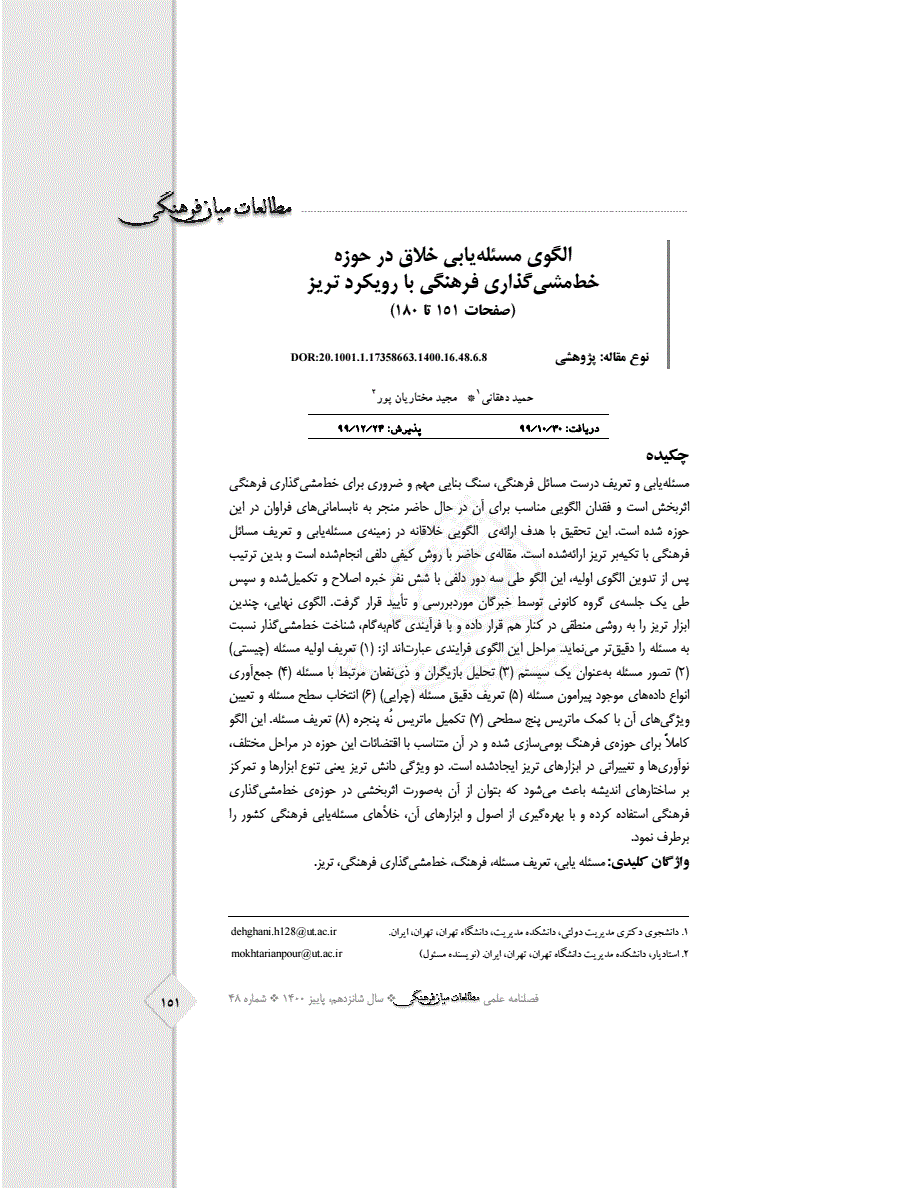چکیده:
مسأله یابی و تعریف درست مسائل فرهنگی، سنگ بنایی مهم و ضروری برای خط مشی گذاری فرهنگی اثربخش است و فقدان الگویی مناسب برای آن در حال حاضر منجر به نابسامانی های فراوان در این حوزه شده است. این مقاله با هدف ارائه الگویی خلاقانه در زمینه مسأله یابی و تعریف مسائل فرهنگی با تکیه بر تریز ارائه شده است. مقاله حاضر با روش کیفی دلفی انجام شده است و بدین ترتیب پس از تدوین الگوی اولیه، این الگو طی سه دور دلفی با شش نفر خبره اصلاح و تکمیل شده و سپس طی یک جلسه گروه کانونی توسط خبرگان مورد بررسی و تأیید قرار گرفت. الگوی نهایی، چندین ابزار تریز را به روشی منطقی در کنار هم قرار داده و با فرآیندی گام به گام، شناخت خطمشیگذار نسبت به مسأله را دقیقتر مینماید. مراحل این الگوی فرایندی عبارتند از (1) تعریف اولیه مسأله (چیستی)؛ (2) تصور مسأله بهعنوان یک سیستم؛ (3) تحلیل بازیگران و ذینفعان مرتبط با مسأله؛ (4) جمعآوری انواع دادههای موجود پیرامون مسأله؛ (5) تعریف دقیق مسأله (چرایی)؛ (6) انتخاب سطح مسأله و تعیین ویژگیهای آن با کمک ماتریس پنج سطحی؛ (7) تکمیل ماتریس نُه پنجره؛ و (8) تعریف مسأله. این الگو کاملاً برای حوزه فرهنگ بومیسازی شده و در آن متناسب با اقتضائات این حوزه در مراحل مختلف، نوآوریها و تغییراتی در ابزارهای تریز ایجاد شده است. دو ویژگی دانش تریز یعنی تنوع ابزارها و تمرکز بر ساختارهای اندیشه باعث میشود که بتوان از آن به صورت اثربخشی در حوزه خط مشی گذاری فرهنگی استفاده کرده و با بهره گیری از اصول و ابزارهای آن خلأهای مسألهیابی فرهنگی کشور را برطرف نمود.
Problem-finding and correct definition of cultural problems is an important and essential basis for effective cultural policy-making and the lack of a suitable model in this field has currently led to many disorders. This article is done aiming to provide a creative model in the field of cultural problem finding and problem definition relying on TRIZ knowledge. This study was done with Delphi qualitative method. After developing the initial model, it was corrected and completed during three rounds of Delphi including six experts and then it was reviewed and approved in a Focus Group meeting. The final model puts together several tools of TRIZ in a logical way and makes the policymaker's cognition more accurate in a step-by-step process. The stages of this process model are (1) initial problem definition (What); (2) defining the problem as a system; (3) analyzing the actors and stakeholders related to the problem; (4) collecting available data about the problem; (5) exact definition of the problem (Why); (6) selecting the problem level and determine its characteristics with help of five-level matrix; (7) complete nine windows matrix and (8) problem definition. This model is completely adapted to the field of culture; and according to the contingencies of this field, has applied innovations and changes in TRIZ tools in deferent levels. The two characteristics of TRIZ knowledge i.e. the variety of tools and focus on thought structures makes it effectively usable for the cultural policy-making field and fill the problem findings gaps by using its principle and tools
خلاصه ماشینی:
در اين پژوهش همچنين سعي شده است ضمن آسيب شناسي وضعيت مسئله يابي در سياست گذاري فرهنگي، پيشنهادهاي مؤثري براي رسيدن به وضعيت مطلوب ارائه شود که انجام کار کارشناسي، تأسيس مؤسسات رصد فرهنگي، نظاممند نمودن مسئله يابي بر اساس الگوهاي ايراني- اسلامي، آموزش و تقويت مديران فرهنگي ازجمله اين پيشنهادها هستند.
(قليپور و غلامپور آهنگر، ١٣٨٩: ٣٨٥) مسئله يابي خلاقانه با رويکرد تريز آلتشولر، مبدع تريز به عنوان کسي که زندگي خود را براي کشف راز «اختراع کردن» گذاشت ، معتقد بود که اختراع کردن چيزي جز يافتن تضادهاي موجود و حل آنها نيست و البته از نظر او اين يافتن تضادها نيز به دانش کافي نياز دارد (شولياک، ١٩٩٧: ٢٤) از نظر آلتشولر يک مسئله دشوار، فقط به دليل ندانستن قوانين توسعه سيستم هاي فني دشوار است .
در اينجا پيشنهاد ميشود که ابتدا فرد با شناخت بهتر و البته عاقلانه تر، پرداختن به مسئله را شروع کند و همچنين به دليل هزينه هاي سنگين پرداختن به مسائل سطح بالا بهتر است کار خود با مسئله را با جست وجوي راهحل سطح پايين براي آن آغاز کرد ( - ٩٣ :١٩٨٤ ,Altshuller ٩٥).
با توجه به ضرورت بهرهگيري از خبرگاني که به طور همزمان در حوزهي حل خلاقانه ي مسئله و تريز و درعين حال حوزه فرهنگ و خط مشي گذاري فرهنگي متخصص باشند، در اين پژوهش براي انتخاب خبرگان، روش نمونه گيري هدفمند و از بين تکنيک هاي نمونه گيري هدفمند نيز روش نمونه گيري بر مبناي اعتبار (اشتهار) ١(٢٠٠٧ ,Teddlie and Yu) مورداستفاده قرارگرفته است .

(پژوهیار,
,
,
)

